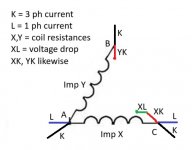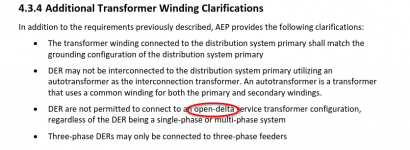That is exactly what I was trying to say in that post. But admittedly I'm not the one able to show why mathematically, I'm just coming at it intuitively.
OK, I've thought about the geometry a while, and I came up with the diagram below, where the voltage point A is taken as the fixed reference. Here for simplicity I'm assuming the coil impedances are predominantly resistive, and the the load currents (for three phase and single phase loads separately) are balanced and in phase with the applied voltages. Which means I omitted the single phase neural point N and any unbalanced single phase load; the single phase current L can just be taken to be the average current through the A-C coil.
So the point of the diagram is to show the phase relationships, i.e. the direction of the voltage drops. The direction I've drawn each current is its phase (up to an unspecified choice of +/- 1). The stinger pot resistance brings the high leg voltage point B downward, which is towards the center of the ABC triangle (what would be the neutral point of a wye secondary). Likewise, the 3 phase current brings the voltage point C towards that same center point. And if the single phase current is a net load, it further moves the voltage point C to the left. If it's a net backfeed, the voltage rise would move it to the right instead.
Implicit in this picture is that this is for small effects where we can consider each effect separately and add them up. E.g. if we think of the three phase current causing a large move of the voltage point C, and then add a large resistive single phase A-C load, the single phase voltage drop would move the voltage point C directly towards A, not to the left.
Now what I'm missing is an appropriate measure of "imbalance" for the 3 phase system. The 3 phase loading on an open delta transformer inherently unbalances the system; the voltage angle BAC becomes less than 60 degrees, and all the voltages get smaller but in an unbalanced manner. Adding a single phase load makes the voltage angle BAC even smaller, but it reduces the voltage A-C which reduces the spread of the L-L voltages when X < Y. Whereas with a net single phase backfeed, we get the opposite.
So without such a measure of imbalance, it's not clear to me if single phase backfeed will cause the the imbalance to get worse. But now I agree that it's a possibility.
Cheers, Wayne




